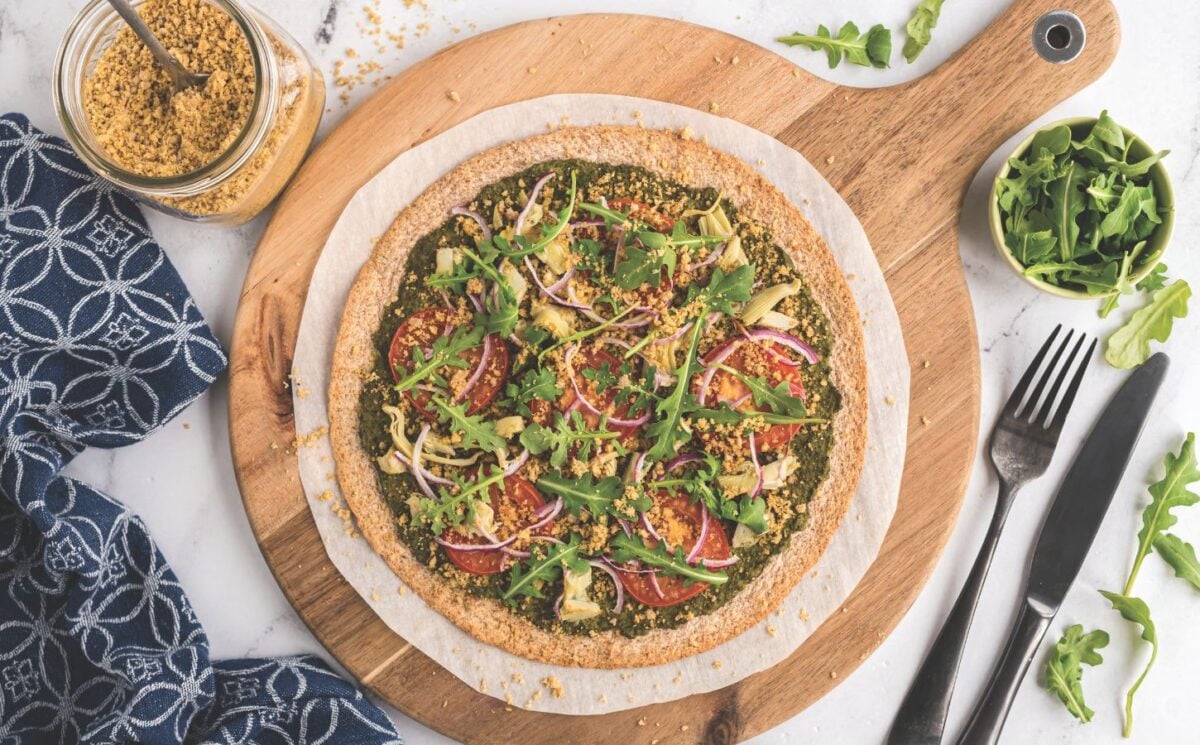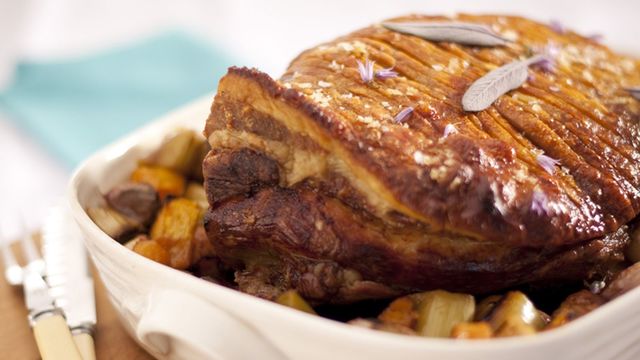
Whether you're after chocolate, vanilla, red velvet, or funfetti, grocery stores today stock boxed cake mixes to suit every craving. Well, nearly every craving. Since debuting the first cake mix in the 1930s, the powers that be have experimented with all kinds of quirky flavors.
While you can still find some of these unique creations on supermarket shelves to this day (shoutout to the likes of Pillsbury's Elf on the Shelf Funfetti and Betty Crocker's Cinnamon Toast Crunch), we've also lost plenty of fun flavors to discontinuation — many of which we doubt we'll ever see again. The reality is that food trends are always changing. That means cake mix flavors that seem fun and relevant right now won't necessarily stay that way, even five years later.
In fact, when you start to look into discontinued cake mix flavors, you can see patterns of food trends over time. For example, the '60s were all about pineapple upside-down cake, while 30 years later, the industry was into all things novelty. Inevitably, a handful of the cake mixes we see in stores today will also meet the same fate at some point.
Until that day comes, here are some of the many boxed cake mix flavors that we've lost over the years. Pillsbury Pink Lemonade Angel Food Cake You know that scene in "Barbie" where Margot Robbie's eponymous character wakes up in a picture-perfect world, drinking pretend tea and eating invisible food? Well, if there had been actual food in Barbieland, we're willing to bet Pink Lemonade Angel Food Cake would've been the dessert of choice. Launched by Pillsbury in 1961 (coincidentally, two years after Barbie herself stepped onto the scene), this boxed cake mix was a pastel pink wonder that combined both sweet and tart flavors to "make any party more fun than a circus" (via ).
Like all angel cakes, it seems like egg whites were the key to the Pink Lemonade Angel Food Cake's light and airy texture. As per ads, each cake contained a whopping 14.4 egg whites in total, which we can't imagine made this mix particularly cost-effective to manufacture.
The mix could be purchased alongside a pink frosting mix, while Pillsbury also offered a deluxe version of the cake that promised to stay moist for at least three days. Sadly, those days are long behind us, as the Pink Lemonade Angel Food Cake was long removed from circulation. Decades later, Pillsbury launched a Pink Lemonade Cake mix in 2012, but even this has since been discontinued — and without the angel food element, it still lacked the magic only 14.
4 egg whites can bring. Betty Crocker Sunkist Orange Cake Colorful cakes were all the rage in the 1960s, with this Betty Crocker Sunkist Orange Cake joining the ranks in 1968. As the name suggests, this was a violently orange-hued creation that used "natural orange flavor, coaxed from fresh orange peel by Sunkist" to make it the "sunniest, brightest-tasting [dessert] you can imagine" (via ).
There was a whole line of products under Betty Crocker's Sunkist line, including the Sunkist Orange Layer Cake, Sunkist Orange Chiffon Cake, and the matching Sunkist Orange Frosting. Today, you'd be hard-pressed to find anywhere near as many orange options in the baking aisle of your local grocery store. While Betty Crocker has plenty of recipes for orange-flavored cake on its website — and you may still be able to snap up a few overpriced old boxes of orange cake mix via secondary sellers — its product lineup is now decidedly orange-free.
Shoppers in 1968 had no idea how lucky they were. Duncan Hines Burnt Sugar Cake You don't come across many burnt sugar cake recipes, but back in the 1950s and 1960s, this was a go-to sweet treat. Unsurprisingly, Duncan Hines got in on the action at the peak of the craze by launching its own Burnt Sugar Cake Mix in 1957.
Even then, it described the cake as an "old-fashioned favorite" and claimed that "only Duncan Hines" offered a mix of this kind, making this a truly unique offering at the time of its release (via ). It's not clear when Duncan Hines pulled this flavor from shelves, but we'd assume the decision to discontinue it happened naturally as burnt sugar desserts fell out of vogue. The silver lining here is that, according to its advertisements, it was each box's supply of burnt sugar syrup that gave both the cake and frosting their deep flavor.
So, if you ever manage to get your hands on said syrup, the world is your oyster. Even easier is to buy or whip up a caramel cake — as, after all, caramel is literally just burnt sugar. Betty Crocker Honey Spice Cake Let's take you even further back in time to when Betty Crocker released its Honey Spice Cake Mix in the 1950s.
This combined hints of honey, cinnamon, cloves, ginger, and nutmeg to create the ultimate fall treat — one that, in the words of a 1951 advertisement, "the men really go for" (via ). As you can imagine, this kind of messaging was all over cake mix marketing in the 1950s. It was actually this kind of housewife and homemaker-oriented sentiment that led to the likes of Betty Crocker adding ad taglines like "You add the eggs for that special homemade goodness" (via ).
When cake mixes first hit the market, sales struggled because, as food historian Laura Shapiro told the , "If you made it from a box, it didn't count." It was at that point that brands decided that housewives might feel more involved and less guilty if they were responsible for adding in real eggs. It worked — once brands started pushing cake mixes that, like the Honey Spice Cake mix, ditched powdered eggs for hand-cracked eggs, sales soared.
The rest is history. Over 70 years later, . Regardless, no marketing tricks are needed for Betty Crocker's Honey Spice Cake Mix, with the flavor doomed to discontinuation many moons ago.
Duncan Hines Sour Cream Chocolate Cake You can't move for chocolate flavor cake mixes in the baking aisle, but we currently live in a world that's far too short on sour cream options. This wasn't a problem in the 1970s when Duncan Hines had us covered with its Sour Cream Chocolate variety — a mix so deliciously chocolatey that the brand claimed it had the stamp of approval from the people of Hershey, Pennsylvania, aka "Chocolate Town, U.S.
A." (via ). It seems that the rest of the U.
S.A. wasn't quite as passionate as the residents of Chocolate Town, as this cake mix is sadly nowhere to be seen today.
While we'd love to see another brand harness sour cream's baking potential like this, there's nothing stopping you from adding it in yourself the next time you make a chocolate cake. Thanks to its natural acidity, sour cream can boost the moistness of baked goods, elevating everything from chocolate cake to pancakes (although, in our experience, ). Betty Crocker Dole Pineapple Cake The American love affair with pineapple upside-down cake first started in the 1920s, but it wasn't until the '60s and '70s that this simple showstopper really solidified itself as a fan-favorite in kitchens nationwide.
It was during this craze that Betty Crocker stepped in with its own pineapple sweet treat — one that packed just as much tropical flavor, and took even less effort to make. Its Dole Pineapple Cake debuted in the late 1960s, complete with its own matching frosting. Both included actual Dole pineapple in their ingredient lists, which meant that the entire thing had a distinctly pineapple-yellow hue.
While we're sure that those particularly passionate about pineapple loved the dessert, we can imagine that this inevitably super sweet yet tart combo of flavors wasn't for everyone. Given that the humble pineapple upside-down cake still retains some kind of presence while Betty Crocker's Dole Pineapple Cake does not, we're probably not too far off the mark. Duncan Hines Dutch Topping Cake Mixes In 1962, Duncan Hines debuted its Dutch Topping Cake Mixes, which were a whole new kettle of fish in the cake mix world.
Instead of giving you the essentials to bake and frost a basic cake, it came with a packet of bake-on, crunchy streusel topping. This was scattered atop your cake pre-baking, which you could then "eat cozy-warm, like the Pennsylvania Dutch do" (via ). The line came in three different flavors: Butterscotch Crunch, Apple N' Spice, and Cinnamon Raisin.
Had we been browsing the cake mix aisle in the 1960s, we think the Butterscotch Crunch would have been our top pick. This covered a straightforward vanilla cake with a thick layer of butterscotch and toasted almonds, giving the cake some tasty textural variety. Of course, it doesn't really matter which mix we would've chosen, considering that Duncan Hines eventually scrapped all three flavors.
Betty Crocker Butter Brickle Cake Mix Butter brickle is a kind of chocolate-coated golden toffee that's tough on the teeth but spectacular on the taste buds. It's over the years, with small chunks traditionally rolled into vanilla. It was this flavor combo that inspired Betty Crocker in 1966, with the chain deciding to capitalize on the butter brickle hype by launching its own Butter Brickle Cake Mix (plus a matching frosting).
Unlike a lot of the cake mixes on this list, Butter Brickle Cake Mix actually managed to stick it out for over 20 years. The flavor was eventually discontinued by Betty Crocker in 1990, but judging by the number of nostalgic recollections shared on social media, the flavor still has a pretty passionate fanbase. While Betty Crocker remains firm on not restoring the actual mix, the good news is that the brand has using Betty Crocker Super Moist Yellow Cake that should get you pretty close to the OG.
Betty Crocker MicroRave Before there were mug cakes, there were Betty Crocker MicroRave cakes. As you'd expect, these were . Anyone looking for a convenient snack could choose from four flavors (yellow cake with chocolate frosting, chocolate cake, yellow cake with vanilla frosting, or a brownie) and have the whole thing done, frosting and all, in just four minutes.
The MicroRave line debuted in 1988 and managed to survive until 1992. While we're pro-mug cake, we're not surprised it didn't manage to become a full-time fixture. As per those who actually tried MicroRave cakes (many of whom seem to have been students at the time), they just weren't up to scratch.
"I've tried several times and no matter what I did, it's always rubbery," said , while that "they tended to bake unevenly and you'd get some raw/burnt spots in the tray. Too much water and they wouldn't bake solid, but not enough water and they had an aftertaste." Even Betty Crocker itself admitted that they were a disappointment, with a spokesperson telling that "the cake came out rubbery and tough, and the consumers commented they didn't like the baked quality even though it was convenient.
" Nowadays, the brand has a line of , which we suppose are MicroRave 2.0. As for the original four flavors, however, we're pretty confident that they'll remain in the Betty Crocker vault forever — and maybe that is for the best.
Duncan Hines Pantastic Muppet Cakes The fact that we live in a world that doesn't truly appreciate cakes shaped like "The Muppets" is a tragedy. Okay, that may be a tad melodramatic, but it's hard to imagine how anyone looks at a baking tin molded to resemble Kermit the Frog and isn't filled with endless wonder. Back in the 1990s, Duncan Hines created the epitome of novelty baking with its Pantastic Party Cake — a kind of yellow cake mix that was paired with both vanilla frosting and frosting coloring packets.
These came in two varieties: Kermit the Frog and Miss Piggy. Other non-Muppet options were also being tested, such as Garfield, but sadly, Duncan Hines decided to pull its Pantastic cake mix line for good. For once, this wasn't necessarily because the mixes were unpopular.
In 1991, Procter & Gamble — the then-owner of Duncan Hines — pulled its Pantastic kits from circulation due to complaints that their accompanying character-shaped tins were smoking or charring in the oven. Pillsbury Fudge Macaroon Cake A whole new kind of cake creativity was in the air in the 1960s, with brands rolling out a seemingly endless train of wacky new flavors. Pillsbury threw its chef's hat into the ring in 1966 with the launch of its Fudge Macaroon Cake, a short-lived boxed mix that dared to answer the bravest of questions: what if a cake contained chocolate and coconut? It's a crazy concept, we know — and so did Pillsbury, with the brand describing its new creation as a "wild new flavor" that's "really something else" in its ads (via ).
Pillsbury once again leaned hard into the fact that husbands would like this cake mix in its marketing. "My man loves it," reads the advertisement, while a woman proudly presents a slice of cake on a plate and a man stands behind her in the shadows. Personally, we think the fact that it was a rich fudge cake, swirled with an assumedly vanilla-flavored cake and stuffed with chunks of real macaroon, topped with a coconut-laden fudge frosting, spoke for itself — but hey, that's just us.
Betty Crocker Snackin' Cake When Betty Crocker introduced its Snackin' Cake line in 1972, it added not one but three new flavors to its lineup. Whether you chose Coconut Pecan, Banana Walnut, or Chocolate Almond, the goal was to give customers the tools they needed to make, bake, and eat a sweet snack, all in the same pan. At the time, Betty Crocker distinguished it from its other offerings by emphasizing this convenience (which we'd argue is a unique marketing choice, considering the fact that, by their very nature, all cake mixes are convenient).
As it bragged in its first ad, "Snackin' Cake is so delicious, it's hard to believe you mix it in only two minutes, using just a fork, spoon and a pan" (via ). The folly of a convenient cake mix seems to have worked — for a while, at least. By 1973, Betty Crocker had expanded to six flavors of Snackin' Cake.
Two more flavors were added by 1975, with yet another joining the ranks in 1982. Betty Crocker kept developing and pushing the line for years until eventually every single of flavor of Snackin' Cake was scrapped for good. Betty Crocker Black Walnut Cake Mix As was the typical line of messaging for most box cake mixes launched in the 1950s, Betty Crocker pitched its Black Walnut Cake as a shortcut to kitchen glory.
As per its ads, this mix promised a "country-kitchen kind of cake" flavored with black walnuts that would "make you famous" and become "your specialty," all with minimal effort on your part (via ). We can't recall a single historical figure who rose to fame via their Black Walnut Cake, but we're sure the box cake mix was very good all the same. Black walnuts are known for their distinct earthy taste and were particularly trendy in the 1950s when they also became a popular ice cream flavor.
This is a more sophisticated choice than a lot of the boxed cake mixes on grocery store shelves today, but we understand why Betty Crocker hasn't brought this flavor back since the '60s. Judging by in the 2000s, it seems like modern palettes just aren't into black walnuts. It also doesn't help that black walnuts have surged in price, which would inevitably force a cake mix like this to come in at a much higher price point.
Recommended.














